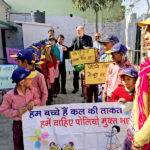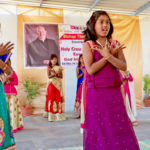
Bishop Thomas Zinkula places dirt in the ground where a tree has been planted in honor of his visit to the Hindu temple led by the Swamiji in the District of Koppal in the state of Karnataka, India. Leaning forward to the right of Bishop Zinkula are Father Francis Bashyam and Swamiji (wearing orange robes). The bishop visited India six weeks ago on an interfaith mission.
By Barb Arland-Fye
The Catholic Messenger
Bishop Thomas Zinkula walked into a quiet, tidy dormitory where children, some with crippled limbs, rested in their beds. One boy wriggled in his bed, bright-eyed and smiling. Here, at the Missionaries of Charity home in Bellary, Karnataka, India, eight nuns and 14 staff care for 110 children and adults with physical and/or mental challenges and who have no other place to call home.
Everyone who could walk or sit up wanted a blessing from their special visitor as he passed through the home’s corridors. His visit here was one of many encounters on the peripheries that Bishop Zinkula made during a 10-day whirlwind tour of India six weeks ago.
His encounters in schools, churches, Hindu and Buddhist temples, community centers and family homes covered many miles and many interfaith experiences that reaffirmed his love for the people of India.
Reflecting back on his trip, the bishop said, “My first experience of interfaith encounter and dialogue occurred while I was a seminarian studying at the Catholic University of America in Washington, D.C. I participated in a program which brought together seminarians from Roman Catholic, Orthodox and Evangelical and African-American Protestant seminaries, along with Jewish rabbinical schools. I found this to be a tremendously fruitful experience. In a sense, it ‘set up’ the interfaith encounters I had in India. My experiences have parallels to Share the Journey, an initiative of Pope Francis. Such encounters open our eyes, minds and hearts to those who walk different paths than us.”
Seven years ago, Bishop Zinkula spent two months in India, the world’s second-most populous country, while on sabbatical as a priest of the Dubuque Archdiocese. As happened during his first trip, his hosts placed garlands around his neck and shawls on his shoulders as an expression of welcome and hospitality.
At the schools he visited, the children, many of whom are Hindus or Muslims living in poverty, reached for a handshake with Bishop Zinkula. They knew of his friendship with priests who lead the schools that provide an opportunity for a brighter future. They know that the bishop’s people back in America provided some of the funding that enhanced their schools.
A homecoming
Bishop Zinkula didn’t protest what he jokingly referred to as “over-the-top hospitality” during his visit. At one school he looked sheepish wearing a too-small turban on his head, a shawl wrapped around his shoulders and a garland around his neck while watching children singing and dancing on stage. But he understood that Indians of different faiths desired to show appreciation for a church leader who traveled halfway around the world to spend time with them.
The bishop packed in many encounters during his brief visit, the pinnacle of which was an audience in northern India with the Dalai Lama, the Nobel Prize laureate and leader of Tibetan Buddhists lauded for his efforts on behalf of world peace. Bishop Zinkula presented the Pacem in Terris Peace and Freedom Award to the Dalai Lama at his temple in the foothills of the Himalayas.
Father Francis Bashyam, who leads a school in the Bellary Diocese and became friends with Bishop Zinkula during his first stay in India, coordinated travel arrangements and overnight stays. The ambitious itinerary had the bishop hopscotching from southern to northern India — by planes, train and automobiles — a total of 40 hours on the road and in the air — not including the flights from Chicago to India and back.
The bishop’s interest in and support of Catholic Relief Services resulted in a visit to a CRS polio eradication project in a slum on the last day of the India tour. He also asked to see Kopoal Swamiji, a Hindu religious leader whom the bishop became friends with through Fr. Bashyam.
At the chancery in the Diocese of Bellary, diocesan Bishop Henry D’Souza, his staff and sisters of the Missionaries of Charity greeted their guest with hugs, a garland and a shawl. Bishop D’Souza, who met Bishop Zinkula during his first visit to India seven years ago, gave a short speech punctuated with humor. Bishop Zinkula told the gathering that his first visit “was one of the highlights of my life, actually.” This second visit “is like coming home for me.”
Taking in culture and faith
Getting from one place to another required travel on sometimes bumpy dirt roads through villages with open-air markets on either side, animals and people crossing the roads , oblivious to the teeming traffic of auto rickshaws, motorbikes and animal-drawn carts. Women washed clothes in a canal, what Fr. Bashyam called “the largest washing machine in the world.”
On his visit to Hampi, a World Heritage Area in the state of Karnataka, the bishop explored the ruins where the “Monkey Kingdom” existed. Monkeys skittered throughout the site; one grabbed a water bottle that the bishop held in his hands behind his back. Some of the architectural gems he viewed: the Narasimha Shrine, featuring a sculpture of a deity formed from a massive boulder in 1528 A.D.; Lotus Mahal, described as a very good example of Indo-Islamic style of architecture; and the Elephants Stable.
Bishop Zinkula celebrated Mass – barefoot — at Holy Spirit Catholic Church, designed by Cedric (Sunny) Suraj, the son of a family who befriended the bishop during his first visit to India. In some areas of India, people remove their shoes before entering a holy space. Introducing his friend, the bishop, to the congregation, Fr. Bashyam spoke in Kannada (the state’s native language) and then translated to English: “This is a homecoming. We welcome Bishop Zinkula and we thank him for coming to us.”
“Like the prodigal son coming back home,” the bishop quipped. “What a beautiful church you have here. It’s great to be back.” Among the design elements is a depiction of the Holy Spirit as a dove, crafted in steel and backlit on the wall behind the altar. A bell tower with an illuminated cross is visible for miles.
The congregation celebrated after Mass with a communal meal on church grounds. Sabina Mary and her husband, Rabel Sagayenraj, remembered the bishop’s visit to their home seven years ago. “We’re very happy he has become a bishop,” Sabina Mary said. Mini John, meeting the bishop for the first time, described him as “down to earth.”
(Next week: A visit to two Catholic schools in India that the Diocese of Davenport helped support.)











